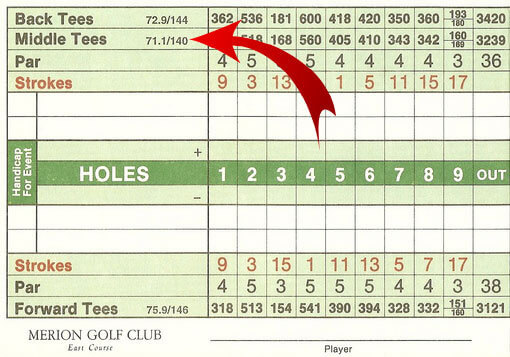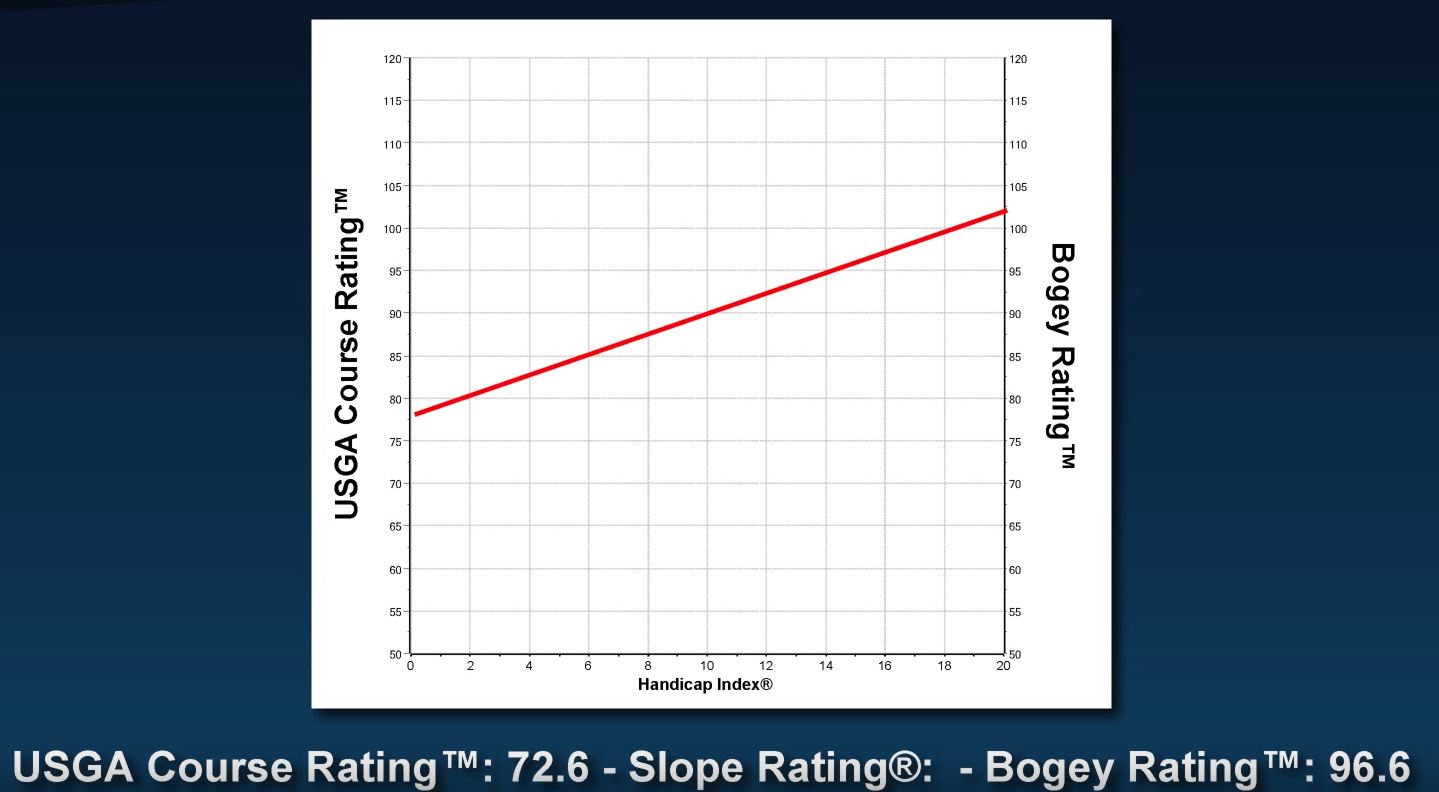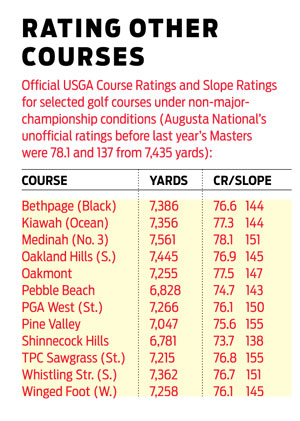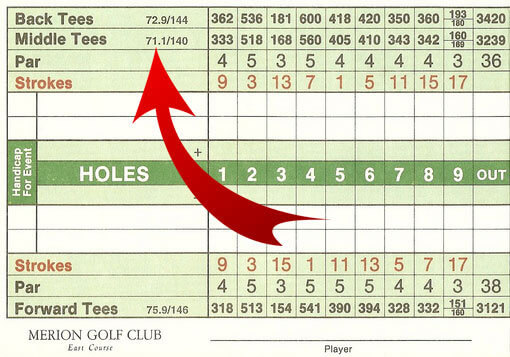What Is Slope Rating In Golf
So what exactly is slope?
Slope tells you what tees play “proportionately harder” for better handicapped golfers than it does for lower handicappers. Slope is a rating which indicates how challenging the tees will play for those with higher handicaps.
That’s it! Slope doesn’t tell you how the course proportionately plays from any other set of tees, let alone tell you how it compares with other courses. A Course Rating is a process which evaluates each hole through both a Scratch or Bogey eye. This process is so thorough that an actual rating for the Bogey golfer is computed and it is the gap between the Scratch and Bogey rating that determines the Slope.
One example is that a set may have a Course or Scratch rating (70.5) and a Bogey ranking (94.3). We expect that the Scratch golfer would average 70.5 for 20 rounds if they used this set. For a player with a Handicap Index below 20.0, we expect him to score around 94.3 in his 20-rounds. A Men’s Slope Rating would be given based on this difference of 23.8 strokes (94.3 – 70.5 = 23.8).
Bogey’s and Scratch’s ratings are very volatile. It is possible for curious things to happen at the Slope when there are several factors that can affect both golfers.
A set of tees with a large number of holes where the Bogey golfer is able to reach the green in regulation will result in an upward pressure being applied on the Slope. Imagine that the Bogey player approaches the green on many of these holes with a fairway or long iron, while the Scratcher has only a wedge. The Bogey player is more vulnerable to greenside problems (bunkers and difficult chips), . . The kind of problems that can lead to high scores. This will cause Bogey ratings to be higher and widen the gaps between the ratings. It can also result in higher Slope.
Take a look at a group of tees located on the same golf course. Most holes in the set are out of reach for Bogey players. Now it is the Scratch golfer who has the longer approach shots, perhaps with mid to long irons, while the Bogey golfer may merely be chipping/pitching to the green in one over regulation. In a way, there has been a shift in the ratio of difficulty. The added length of the tees will cause both rating to increase, but the gap between Scratch Rating and Bogey Rating may remain relatively steady or could widen at an extremely slow rate.
These upward and downward pressures help explain why a Slope rating may increase sharply at a course from the Gold tees to the White tees (Bogey rating rising much faster than Scratch rating as the approach shots become longer), yet hardly change from White to Blue (gap increasing slowly due to shorter approach shots of Bogey golfer). You can also see how a shorter course might be given a Slope Rating that is a little too high. Or, how a longer course could be assigned a Slope Rating that is a little lower.

History of Slope Rating
In 1979, the USGA established the Handicap Research Team (HRT) in an effort to improve their handicap system and account for variations in the playing difficulties for players of various abilities.
It was 1977 when Lieutenant Knuth became Lt. As a student at the Naval Postgraduate School, Commander Dean Knuth had made improvements to the course rating system. This included weighted ratings that covered ten attributes for each hole. The adjustment was to the distance rating. It was to be the basis for the present USGA Course Rating System. After moving to Norfolk in Virginia, Knuth created the Bogey Rating System by studying data obtained from average volunteer scores at local courses. Knuth went on to serve as the USGA’s Senior Director of Handicapping for 16 years, beginning in 1981.
HRT’s research and Knuth’s calculation resulted was a calculus based upon the difference between the course ratings and bogey ratings. This numerical measure gave a measurement of how difficult it is for scratch golfer and bogey player. The calculations could be used in order to adjust golfer’s handicaps depending on where they are playing. These are the foundations of the current slope system. Under the direction of HRT member, Dr. Byron Williamson, all Colorado Golf Association courses were rated using this new method in 1982. Colorado tested the Slope System and had good results. Five states were also involved in this test, which was conducted before the national slope system became available. Each USGA Course Rating System is used by all golf associations that rate golf courses in the United States.
The USGA Course Rating System uses the USGA Slope Rating System as the base for most of the top handicapping methods around the globe, including The R&A’s World Handicap System. It was jointly developed by The R&A, and it will begin to be implemented globally in 2010.

Let’s see how we can help today!
What do Course Ratings and Slope mean?
Modified: Tuesday, 7 October 2020 at 12:29pm What is golf slope? Is there a way to calculate a golf course rating? To help golfers better understand golf course ratings and golf slop we’ll provide some details.
USGA Course Ratings are a rating of the difficulty of a particular course. (More specifically, the number is an estimate of the average scores of the best 50-percent of rounds played by scratch golfers at the course being rated.) It is simple to grasp because the course rating is in strokes. An easy par-72 course may be given a course rating 68.9 and a challenging course might receive a course rating 74.5. That means that a scratch golfer should be expected to average 68.9 strokes in his better rounds at the easier course; and 74.5 at the more difficult one.
Slope rating is a term that the United States Golf Association owns. This tells golfers about how difficult the golf course will actually be for them.
To put it another way: USGA Course Rating tells the best golfers how hard a golf course actually plays; USGA Slope Rating indicates how much harder the course plays for “regular” (meaning not among the best) golfers.
55-grade slope is the minimum rating and 155 is the max. The slope does not include strokes that are played, but course rating. The more challenging the course, the higher its slope. The slope rating system for golf was created by the USGA in 2001. It set the slope at 113. However, many 18-hole courses don’t have such low slope ratings. While some do have slope ratings of 113, the average in real life is much higher than that. However, certain handicap calculations still use a slope of 113. http://golf.about.com/cs/golfterms/g/bldef_courserat.htm http://golf.about.com/cs/rulesofgolf/a/hfaq_sloperate.htm Use the free Golf Pad app to automatically see rating and slope details for over 40,000 golf courses around the world. Golf Pad Premium calculates your playing handicap for you automatically so that all details are taken care of.

Course Rating Facts
Q: What’s SLOPE?
A: Most golfers believe that the higher the Slope Rating, the more difficult the golf course. This is dependent on the level of your golf game. Slope Ratings are a way to determine how difficult a particular course is for bogey (roughly a 20 handicap) and scratch players. Slope Ratings indicate how challenging the course is to bogey and scratch players. Slope Ratings may range between 55 and155. In the United States, the average slope rating is approximately 120.
Slope Rating allows you to convert your Handicap Index in to a Course Handicap. The player can receive sufficient strokes on a set of tees in order to play at the same level with scratch golfers.
A scratch rating is used to determine the rating of your course. The bogey rating can also be calculated from each set. The scratch rating refers to the same concept as the Course Rating except that it is for Bogey-golfers. A formula is created from the scratch rating and the bogey rating to calculate the Slope Rating.
Q: What is the best way to rate courses?
A: Leading the LGA’s Course Rating Team is an LGA staff member with experience, having been trained by the USGA’s Golf Course Rating System. Each licensed golf association has been instructed to use exactly the same processes that the USGA provides.
Louisiana has approximately 20-25 volunteers who help the LGA assess a course. Every member of the committee is trained in rating course courses.

What is Course Rating and Slope?
You will need to know the Course Rating and Slope if you are an official handicap player for USGA. Every time you turn in a score you are required to record the Course Rating and Slope for the course and set of tees you played. Golfers may be familiar with Course Rating and Slope. However, they don’t know how to interpret them.
Course Rating A Course Rating refers to the course’s difficulty for scratch players or “par”. For example, if a course has a par of 72, the Course Rating might be 71.4. This score is what the scratch golfer must shoot at the course. It increases in difficulty as the course gets more challenging. For each set of tees, a rating is issued. For example, the rating of the blue tees is 72.8; the rating for white tees is 71.0.
How come two measurements are being used to measure the difficulty of a course
The USGA observed in 1980 that, no matter how challenging a course may be, the top golfers always score close to par. The course’s difficulty is more detrimental to less-experienced golfers. Course difficulty is more common for less skilled players. On the basis of this data, the handicap system was modified in 1980 to add a second measure known as Course Slope.
Course Slope. Course Slope represents the difficulty of a particular course to a “bogey golfer”, someone who shoots over par 18 and 90. Course Slope is a number between 55 and 155, with 113 being the average. Higher numbers indicate more difficulty. A slope rating will be assigned to each set. For example, the blue tees might be 123, the white tees 119, and the red tees 114.
Example In most cases, the challenges a course presents to a scratch golfer are different than those faced by bogey golfers. So, two courses can have Course Ratings of 72. The Course Slope for one course might be 113, while the Course Slope for the other may be 135. It is possible to do this by using the following steps:
The course rated at 72 with a slope of 113 is probably not a long course. It may have wide fairways with few hazards. On this course, the par golfer scores par and the bogey-golfer shoots 90.

Golf Slope Rating And How It Relates To Your Golf Game
A golf scorecard is full of numbers. Before you go to the first tee you will only be paying attention to some of the numbers, such as the par and total yards. Many golfers choose which tees they will play on the basis of the yardage. While a high handicapper will want to limit the total yardage to 6,000 yards, midhandicappers can manage at 6500 yards and advanced players will enjoy a challenge that goes to 7,000 yards. No matter what level of player you are, the yardage for the course can tell you a lot about which tees are best for your game.
However, there are other numbers on the scorecard that warrant your attention. It is important to pay particular attention to the two other numbers, the course rating (or slope rating). While these may appear to be two different numbers, they really are quite distinct. This is because the rating’s intended audience differs.
Course rating can be used to describe a level of difficulty that’s appropriate for scratch players. The slope rating, on the other hand, is used to compare scratchers to those with a higher score. This concept should become clearer as we move through this detailed explanation of what golf slope rating is and how it relates to your own golf game.

Setting Goals For Your Game
You can use information from the slope rating, even if your goal is not to compete in any competitions. Imagine that you’re an 18-handicapper and your goal is to break 90 per round. When you tee it up at a new course, you can glance at the slope rating to decide what kind of scoring goal is realistic for the day. You might prefer to play a course that has a 130-foot slope to your goal of 90. However, you might aim for 85 in a course where the slope is low-100’s.
Also, you can consult the slope rating before starting a round to decide which tees you should play. For courses with low slope ratings, it may not be difficult to step back and walk a few extra miles. However, if the course is challenging, you might feel more comfortable moving up to play from slightly shorter distances.
Another suggestion would be to keep track of your scores over time as compared to the slope rating of the courses you’ve played a golf scorecard keeper like this one is often an excellent way to keep old scorecards organized. Comparing your scores with the slope ratings of courses that you have played over the years will help you identify patterns and determine if you are improving. With time, you will be able to identify the best slope rating for your game.
It doesn’t matter if you are an expert or not, but it helps to learn the basics of the USGA’s rating system. Knowing the meaning of slope rating and course rating will help you make informed decisions regarding which tees and score you’re able to achieve.
Cover Photo via Flickr.

What’s a Slope Rating, Anyway?
While the course rating indicates the difficulty of a course for a scratch golfer, the slope rating, by contrast, indicates how difficult the course should be for a bogey golfer (or someone who averages +18 for 18 holes). Also unlike course rating, slope values can range from 55 to 155 with 113 being the average.
Although you may think that slope ratings are similar to course ratings you’re actually falling for one the biggest misconceptions about these ratings. No, slope ratings are not the same as a course score. But what information do they provide?
Course ratings indicate the difficulty of a course. However, slope ratings show how difficult it is for high handicap players.
If you have two courses with a 72 course rating, then they must be equal in difficulty for scratch golfers. For example, if course A has a slope rating of 90 but course B has a slope rating of 95, this would indicate that the course is of higher difficulty to higher handicap players.
To calculate your handicap on a course, multiply your handicap times the course rating by 113. This will adjust your handicap to the difficulty of the course.

The Harder for Whom? Or: You can’t compare golf course difficulty from slope rating alone!
A course with a Slope Rating of 135 is not necessarily more difficult than a course with a Slope Rating of 113. A golf course’s difficulty cannot be compared solely by its Slope Rating.
Let that sink in for a moment.
This concept can be understood if you have a habit of understanding what we refer to as your Target Score. Target Score is a way to show how well you are able to play on any given set of greens. This can be based on your handicap. The Target Scores will be displayed on two different courses by two different golfers.
It doesn’t require much math and it is quite revealing:
Find out your Course Handicap. Your Handicap Index is converted into the Slope Rating of your round.
Update your Course Handicap with the USGA Course Rating from that identical set of tees
Your Handicap Index is what determines how well you can play. The result, also called your Target Score or predicted score, is this?
What is a Good Slope Rating for a Golf Course?
A golf course’s average slope rating is 113. If the slope of a golf course is less than 113, the course is easier than the average golf course.
What is a Slope Rating of 130?
From Tom’s tees, a slope of 130 gives him a 12 Course Handicap. Mary is awarded one stroke and the difference between course ratings (or 73.2 – 71.1 = 2.1). Rounded to the nearest whole number Add 5 to the number.
How does Slope rating Work in Golf?
Slope merely tells you how “proportionately” more difficult that particular set of tees plays for the higher handicapped golfers as opposed to lower handicapped golfers. Slope is a rating which indicates how challenging the tees will play for those with higher handicaps. That’s it!
What is The Best Slope Rating in Golf?
The average scratch golfer will score 68.9 for the easiest course and 74.5 for more difficult. May 7, 2020
.What Is Slope Rating In Golf

